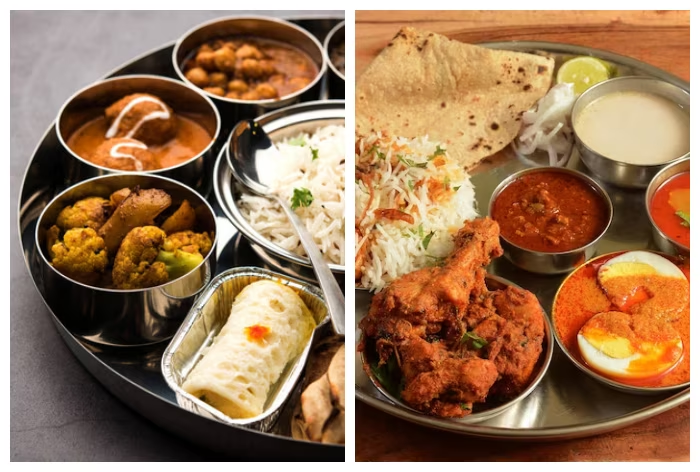
Rita F Mukand
It is interesting to note that the 2014 Sample Registration System Baseline Survey reports that approximately 71% of Indians follow a non-vegetarian diet while 30% of the Indian population follows a strict vegetarian diet highlighting the reality that most Indians eat meat.
A recent event where the IIT-Bombay designated six tables in a common canteen for vegetarian diners, stating they aim to foster inclusivity due to health concerns raised a furor among the public. An email from the mess council emphasized potential "nausea" or "vomiting" among students who see non-vegetarian food. The council warned of "appropriate penalties" for rule violations following discussions among hostel wardens and mess councilors. The common canteen with 80-100 tables now reserves six for vegetarian diners, accommodating seven to eight people per table.
In India, some people use different cooking utensils and cutlery for vegetarian and non-vegetarian food. Others, while entertaining vegetarians, ensure that there are no non-vegetarians on the guest list!

Vegetarian thali and non-vegetarian thali
The food we eat goes centuries into culture and regions where people live, environmental factors, climate, and geographical regions. These factors have shaped the distinct culinary identities of individuals throughout history. This pivotal aspect of our lives contributes significantly to our personal histories, lifestyles, individuality, and, ultimately, the cuisine we embrace. Thus, noting our culture of diversity, we need to learn openness to develop a middle table where we can eat together without wrinkling our noses are each other's cuisines.
Geographical Regions Shape Our Culinary Choices
Living in a frigid, glacier-covered land, like Iceland, meat becomes a necessity. The challenging, icy terrain makes it nearly impossible for crops and vegetables to thrive, making meat the primary sustenance. Icelandic cuisine prominently features lamb, fermented shark, and a diverse array of fish. In ancient times, the ease of trading and acquiring crops was not as readily available as it is today. Similarly, in the bygone era of the Soviet Union, the staple diet revolved around potatoes and meat. In historic Norway and Finland, hunting was ingrained as a way of life, and the practice of hunting was unquestioned, shaping their dietary habits for generations.
In Tibet, a land which is primarily Buddhist and as we know, they believe in non-violence where even to kill a vegetable was a “sin”, meat has to be consumed in the high roof of the world terrain where very scarce crops can grow. Many Buddhist monks eat meat whereas in their religion, they are not to kill any animal but terrain made meat eating a necessity. Meat dishes will likely be yak, goat, or mutton, often dried, or cooked into a spicy stew with potatoes.
All living things form the food chain as their eating line, a linear network of links in a food web starting from producer organisms such as grass or trees which use radiation from the Sun to make their food and ending at apex predator species such as tigers, killer whales, and shark. Detritivores such as earthworms, woodlice, leeches, or decomposer species such as fungi or bacteria, started to eat other living things. Wherever we live, we would eat according to their availability. People who lived near forests ate wild boar and were hunters, those in islands and seacoasts ate fish, while wild animals developed carnivorous teeth to tear the animal flesh that they had to eat to survive. This all followed the natural law of nature.
Representative image
In India, where fruits and vegetables grow galore, it is easier to make rules and laws about who should eat what because Indians have a kaleidoscopic wealth of choices due to its pleasant weather and rich topography.
Food habits soak into the essence of our being
Over the ages, vegetarians become accustomed to their dietary choices which led some to have a strong aversion to the smell of meat. Vegetarians fulfill their protein needs through a variety of plant-based sources, such as nuts, seeds, soy, eggs, dairy products, and select whole grains. On the other hand, omnivores have higher shots of protein in their diet. If one takes meat off their diet, they will feel physically drained, fall prey to mild fatigue or serious effects like severe depression, chronic sleep issues, and slow recovery from illness or injury because the body has lost the high level of protein their body has acclimatized to.
Vegans often accuse omnivores, and meat eaters of being more cruel and violent but vegetarianism doesn’t make a person calmer or kinder or less lustful than a non-vegetarian. It boils down to the essential nature of each person, their DNA, soul essence, and not the food they eat.
If there are segregated zones for people to eat, it will provoke cultural intolerance. This happens in schools where school authorities ban the children from bringing meat items in their Tiffin boxes because some vegetarian parents complain. Ultimately, some vegetarians treat non-vegetarian students as “outcasts”.
Lately, the municipal authorities in Gujarat's Rajkot, Vadodara, and Junagarh have issued orders, requiring the removal of all non-vegetarian food carts from the roadside unless these carts are adequately covered. The rationale behind these directives is that the public display of meat, fish, poultry, and eggs is considered offensive to religious sentiments and is seen as a cause of traffic congestion. These fresh regulations mandate that anyone desiring to sell meat in any form must secure the necessary license from the relevant authorities. Moreover, individuals operating non-vegetarian food carts are obligated to pay an annual registration fee of Rs 100. These laws inculcate a culture of intolerance.

Vegetables and fruit or Chicken?
When Indian international leaders participate in global meetings, they may find themselves seated alongside individuals with diverse dietary preferences, including non-vegetarians. Consequently, it becomes essential to cultivate the ability to dine harmoniously at the same table. Many important business negotiations occur during meals, which can feature an array of both vegetarian and non-vegetarian dishes. In such settings, segregating delegates into different tables, potentially resorting to shouting across the room or even using microphones, creates an awkwardly divisive atmosphere that emphasizes differences rather than fostering unity and collaboration under a single banner.
In international forums and global visits, we observe Prime Minister Narendra Modi comfortably sharing a meal with other world leaders, some of whom may consume meat. This harmonious coexistence is only achievable when both sides actively cultivate sentiments of acceptance and inclusivity to strengthen their diplomatic relationships.
Indian students, software engineers, business people, scientists, and others residing worldwide often need to develop the skills necessary to adapt to non-vegetarian dining situations. When engaging in discussions of vital matters during a meal, they might find it impractical to request separate tables nor can they shout across the room, or speak even with mikes, the atmosphere would be quite awkwardly divisional. While it is possible to do so, such a request could potentially constrain their opportunities for interaction and collaboration with others.
Openness about food choices
The hallmark of a modern society is its openness—a willingness to embrace and be tolerant of diverse influences, ideas, and inclinations, ultimately enriching the collective experience. The obsession with notions of racial purity in Germany during the 1930s ultimately led to the catastrophic event known as the Holocaust. We can only anticipate where a distorted vision of India's "cultural purity" may lead us in the future.
During the 2018 Kerala floods where nearly 500 people died, some vegetarians were actually of the opinion that this happened because Keralites eat beef. Using the same logic, one could say that no disasters happen in states that banned beef, which is not true and every area has had its share of disasters. For that matter, Nepal banned beef, but the April 2015 Nepal earthquake killed nearly 9000 people and injured 21,952 more. Thus, a lot of the desire to ban meat is also rooted in superstitions. Logic and science are needed to counter superstitions.
The G20 theme 'One Earth, One Family, One Future' aimed to build a platform of inclusion. Prime Minister Narendra Modi said, " "India's G20 presidency has become a symbol of inclusion, of 'sabka saath' both inside and outside the country. This has become the People's G20 in India. ” In keeping with this theme, inclusivity of respecting our different food choices becomes paramount, in a country of over one billion people and no one should judge or mock others on the food that one eats.
Rita F Mukand is a writer and journalist.
